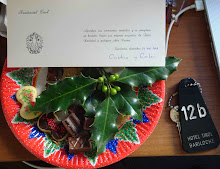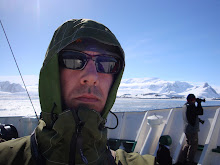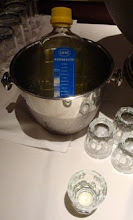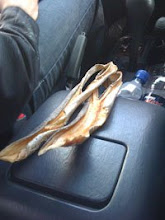Semi-loyal reader Chitchatchinese asks: what’s a Zodiac?
OK, Zodiacs. They are the motorized inflatable rubber pontoon crafts used as utility watercraft around the world. They look like river rafts for tourists, except they have a motor and propellor in the back. Think: Jacques Cousteau. “Phillippe gently nuzzles ze pregnant humpback weef ze prow of ze Zodiac. Ze black rubber pontoon bumps ze female as she prepares to geeve birth…”
The Zodiac boats on the Prof M are used for all kinds of “tender” operations: ferrying passengers to the shore, cruising passengers around bays and channels, accompanying kayaks, transferring crew and light equipment, surveying… We load the Zodiacs by walking down the gangway on the starboard side of the boat from Deck 3, the main deck, moving onto the boats by gripping the arm of a Russian crew member on a Zodiac with a “sailor’s grip” and stepping onto the pontoon and into the board, where we immediately sit on a pontoon on one side or the other, typically squeezing 5 passengers on a side.
The boats are powered by an outboard motor and prop, and the Russian crew member or tour staff typically stands in the stern of the boat and steers the outboard. The boats are highly maneuverable and flexible.
A few idiosyncracies about the Prof M Zodiac-ing:
Keeping track
The system for keeping track of whether someone is on board the Prof M or not is dismayingly simple. There is a tagboard on Deck 3 near the door to the gangway. There are a series of round plastic tags on hooks with numbers. Every passenger has a number. When you leave the boat, you flip the tag around to read the word, “OFF”. When you return, you flip it back to your number. When all the numbers face outward, the crew of the Prof M is free to pull anchor and steam off. So, if you forget to flip your number when you leave the Prof M, and you don’t make it back, no one necessarily will know, and you could be stranded. On the other hand, this scenario depends on you making two mistakes, and I suppose if you make two mistakes like this, you probably deserve to freeze to death anyway. A similarly simple system is used on shore: everyone is required to wear inflatable life vests before boarding a Zodiac from the Prof M, and everyone is required to pile their vests on shore in a central location after disembarking the Zodiacs. When the pile is all used up on reboarding the Zodiacs, that means all are accounted for. So, really, one would have to make three mistakes to get left on shore. Once I understood that, I realized that the system for tracking passenger locations was actually pretty robust. So, I didn’t die of hypothermia from being stranded in Antarctica. As it turns out.
Noise
Cruising around on the Zodiacs is fun, but it’s always a little noisy, and when moving slowly, you smell the exhaust. This makes me glad to have stuck to my decision to find a kayaking trip, even though it took two years.
Boots
On landing, you typically step into shallow water, so required equipment is Wellington-style rubber boots. We all have ‘em. But, the OceanWide Expeditions** organization takes its stewardship role seriously, and takes pains to make sure that what gets on our boots (mainly pink-colored penguin guano) doesn’t make it to the next landing beach, where it could bring contamination and disease to a new penguin colony, or introduce new bugs. So, when we get back on board the Prof M., in addition to turning your number tag around, you have to immediately wash/rinse your boots on the bow in a couple of tubs of disinfectant, scrubbing the bottoms with nylon brushes that are kept jammed into some railing.
Sunday, December 21, 2008
What’s your Zodiac?
Subscribe to:
Post Comments (Atom)















































No comments:
Post a Comment